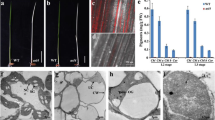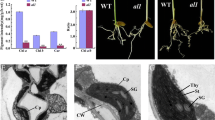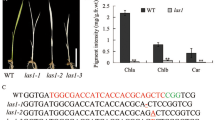Abstract
The chloroplast is a semiautonomous photosynthetic organelle that is essential for plant growth and development, particularly in crops via manipulation of its photosynthetic capacity and the biosynthesis of carbon skeletons. Plastid ribosomal proteins (PRPs) are crucial for the establishment of the transcription/translation apparatus during chloroplast differentiation. In this study, we isolated and characterized T-DNA-tagged rice mutants with defective chloroplasts, named prpl3, that exhibited a distinct albino seedling lethality. Transmission electronic microscopy (TEM) observations showed that the grana stacks in the mutant were not properly formed, with disrupted thylakoid structures in their chloroplasts. Chlorophyll content was also significantly reduced in the leaves of prpl3 mutant seedlings. PRPL3 contains nuclear genes encoding PRPs localized to the chloroplasts, and prpl3 represents a novel mutant presentation of an impaired PRPL3 gene. Our findings also demonstrated that PRPL3 is responsible for phenotypic alterations by generating additional mutant alleles thereof using CRISPR/Cas9 systems. Expression levels of genes involved in photosynthesis and chloroplast development, including plastidial transcription and translation and photosynthesis, were altered in the prpl3 mutant. These results collectively demonstrate that nuclear-encoded PRPL3 is indispensable for the proper development of chloroplasts in rice.
Similar content being viewed by others
References
Ahmed T, Shi J, Bhushan S (2017) Unique localization of the plastid-specific ribosomal proteins in the chloroplast ribosome small subunit provides mechanistic insights into the chloroplastic translation. Nucleic Acids Res 45:8581–8595
Barkan A (1993) Nuclear mutants of maize with defects in chloroplast polysome assembly have altered chloroplast RNA metabolism. Plant Cell 5:389–402
Bieri P, Leibundgut M, Saurer M, Boehringer D, Ban N (2017) The complete structure of the chloroplast 70S ribosome in complex with translation factor pY. EMBO J 36:475–486
Emanuelsson O, Nielsen H, von Heijne G (1999) ChloroP, a neural networkbased method for predicting chloroplast transit peptides and their cleavage sites. Protein Sci 8:978–984
Gong X, Jiang Q, Xu J, Zhang J, Teng S, Lin D, Dong Y (2013) Disruption of the rice plastid ribosomal protein s20 leads to chloroplast developmental defects and seedling lethality. G3 (Bethesda) 3:1769–1777
Gothandam KM, Kim ES, Cho H, Chung YY (2005) OsPPR1, a pentatricopeptide repeat protein of rice is essential for the chloroplast biogenesis. Plant Mol Biol 58:421–433
Han CD, Coe EH Jr, Martienssen RA (1992) Molecular cloning and characterization of iojap (ij), a pattern striping gene of maize. EMBO J 11:4037–4046
Hess WR, Prombona A, Fieder B, Subramanian AR, Borner T (1993) Chloroplast rps15 and the rpoB/C1/C2 gene cluster are strongly transcribed in ribosome-deficient plastids: evidence for a functioning non-chloroplast-encoded RNA polymerase. EMBO J. 12:563–571
Hess WR, Muller A, Nagy F, Borner T (1994) Ribosome-deficient plastids affect transcription of light-induced nuclear genes: genetic evidence for a plastid-derived signal. Mol Gen Genet 242:305–312
Jefferson RA (1989) The GUS reporter gene system. Nature 342:837–838
Jeon JS, Lee S, Jung KH, Jun SH, Jeong DH, Lee J, Kim C, Jang S, Yang K, Nam J, An K, Han MJ, Sung RJ, Choi HS, Yu JH, Choi JH, Cho SY, Cha SS, Kim SI, An G (2000) T-DNA insertional mutagenesis for functional genomics in rice. Plant J 22:561–570
Jeong DH, An S, Kang HG, Moon S, Han JJ, Park S, Lee HS, An K, An G (2002) T-DNA insertional mutagenesis for activation tagging in rice. Plant Physiol 130:1636–1644
Jung KH, Hur J, Ryu CH, Choi Y, Chung YY, Miyao A, Hirochika H, An G (2003) Characterization of a rice chlorophyll-deficient mutant using the T-DNA gene-trap system. Plant Cell Physiol 44:463–472
Kim SL, Choi M, Jung KH, An G (2013) Analysis of the early-flowering mechanisms and generation of T-DNA tagging lines in Kitaake, a model rice cultivar. J Exp Bot 64:4169–4182
Kim SR, Lee DY, Yang JI, Moon S, An G (2009) Cloning Vectors for Rice. J Plant Biol 52:73–78
Kleine T, Maier UG, Leister D (2009) DNA transfer from organelles to the nucleus: the idiosyncratic genetics of endosymbiosis. Annu Rev Plant Biol 0:115–138
Kumar S, Stecher G, Tamura K (2016) MEGA7: Molecular Evolutionary Genetics Analysis Version 7.0 for Bigger Datasets. Mol Biol Evol 33:1870–1874
Lee S, Kim JH, Yoo ES, Lee CH, Hirochika H, An G (2005) Differential regulation of chlorophyll a oxygenase genes in rice. Plant Mol Biol 57:805–818
Lee S, Jeon JS, Jung KH, An G (1999) Binary vectors for efficient transformation of rice. J Plant Biol 42:310–316
Lee J, Park JJ, Kim SL, Yim J, and An G (2007) Mutations in the rice liguleless gene result in a complete loss of the auricle, ligule, and laminar joint. Plant Mol Biol 65:487–499
Lin D, Jiang Q, Zheng K, Chen S, Zhou H, Gong X, Xu J, Teng S, Dong Y (2015) Mutation of the rice ASL2 gene encoding plastid ribosomal protein L21 causes chloroplast developmental defects and seedling death. Plant Biol (Stuttg) 17:599–607
Lichtenthaler HK (1987) Chlorophylls and carotenoids: Pigments of photosynthetic biomembranes. Methods Enzymol 148:350–382
Liu W, Fu Y, Hu G, Si H, Zhu L, Wu C, Sun Z (2007) Identification and fine mapping of a thermo-sensitive chlorophyll deficient mutant in rice (Oryza sativa L.). Planta 226:785–795
Livak KJ, Schmittgen TD (2001) Analysis of relative gene expression data using real-time quantitative PCR and the 2−ΔΔCT method. Methods 25:402–408
Ma ZR, Dooner HK (2004) A mutation in the nuclear-encoded plastid ribosomal protein S9 leads to early embryo lethality in maize. Plant J 37:92–103
Moller (2009) Plastids Annual Plant Reviews, Volume 13, Wiley-Blackwell
Morita-Yamamuro C, Tsutsui T, Tanaka A, Yamaguchi J (2004) Knock-out of the plastid ribosomal protein S21 causes impaired photosynthesis and sugar-response during germination and seedling development in Arabidopsis thaliana. Plant Cell Physiol 45:781–788
Naito Y, Hino K, Bono H, Ui-Tei K (2015) CRISPRdirect: software for designing CRISPR/Cas guide RNA with reduced off-target sites. Bioinformatics 31:1120–1123
Park SY, Yu JW, Park JS, Li J, Yoo SC, Lee NY, Lee SK, Jeong SW, Seo HS, Koh HJ, Jeon JS, Park YI, Paek NC (2007) The senescence-induced staygreen protein regulates chlorophyll degradation. Plant Cell 19:1649–1664
Pesaresi P, Schneider A, Kleine T, Leister D (2007) Interorganellar communication. Curr Opin Plant Biol 10:600–606
Pesaresi P, Varotto C, Meurer J, Jahns P, Salamini F, Leister D (2001) Knock-out of the plastid ribosomal protein L11 in Arabidopsis: effects on mRNA translation and photosynthesis. Plant J 27:179–189
Qiu Z, Chen D, He L, Zhang S, Yang Z, Zhang Y, Wang Z, Ren D, Qian Q, Guo L, Zhu L (2018) The rice white green leaf 2 gene causes defects in chloroplast development and affects the plastid ribosomal protein S9. Rice (N Y) 11:39
Reynolds ES (1963) The use of lead citrate at high pH as an electron-opaque stain for electron microscopy. J Cell Biol 17:208
Rogalski M, Ruf S, Bock R (2006) Tobacco plastid ribosomal protein S18 is essential for cell survival. Nucleic Acids Res 34:4537–4545
Rogalski M, Schottler MA, Thiele W, Schulze WX, Bock R (2008) Rpl33, a nonessential plastid-encoded ribosomal protein in tobacco, is required under cold stress conditions. Plant Cell 20:2221–2237
Romani I, Tadini L, Rossi F, Masiero S, Pribil M, Jahns P, Kater M, Leister D, Pesaresi P (2012) Versatile roles of Arabidopsis plastid ribosomal proteins in plant growth and development. Plant J 72:922–934
Ryu CH, You JH, Kang HG, Hur J, Kim YH, Han MJ, An K, Chung BC, Lee CH, An G (2004) Generation of T-DNA tagging lines with a bidirectional gene trap vector and the establishment of an insertion-site database. Plant Mol Biol 54:489–502
Schein AI, Kissinger JC, Ungar LH (2001) Chloroplast transit peptide prediction: a peek inside the black box. Nucleic Acids Res 29:E8
Schippers JH, Mueller-Roeber B (2010) Ribosomal composition and control of leaf development. Plant Sci 179:307–315
Schultes NP, Sawers RJH, Brutnell TP, Krueger RW (2000) Maize high chlorophyll fluorescent 60 mutation is caused by an Ac disruption of the gene encoding the chloroplast ribosomal small subunit protein 17. Plant J 21:317–327
Song J, Wei X, Shao G, Sheng Z, Chen D, Liu C, Jiao G, Xie L, Tang S, Hu P (2014) The rice nuclear gene WLP1 encoding a chloroplast ribosome L13 protein is needed for chloroplast development in rice grown under low temperature conditions. Plant Mol Biol 84:301–314
Su N, Hu ML, Wu DX, Wu FQ, Fei GL, Lan Y, Chen XL, Shu XL, Zhang X, Guo XP (2012) Disruption of a Rice Pentatricopeptide repeat protein causes a seedling-specific albino phenotype and its utilization to enhance seed purity in hybrid Rice production. Plant Physiol 159:227–238
Tiller N, Bock R (2014) The translational apparatus of plastids and its role in plant development. Mol Plant 7:1105–1120
Tiller N, Weingartner M, Thiele W, Maximova E, Schottler MA, Bock R (2012) The plastid-specific ribosomal proteins of Arabidopsis thaliana can be divided into non-essential proteins and genuine ribosomal proteins. Plant J 69:302–316
Wang P, Gao J, Wan C, Zhang F, Xu Z, Huang X, Sun X, Deng X (2010) Divinyl chlorophyll(ide) a can be converted to monovinyl chlorophyll(ide) a by a divinyl reductase in rice. Plant Physiol 153:994–1003
Wang WJ, Zheng KL, Gong XD, Xu JL, Huang JR, Lin DZ, Dong YJ (2017) The rice TCD11 encoding plastid ribosomal protein S6 is essential for chloroplast development at low temperature. Plant Sci 259:1–11
Wu Z, Zhang X, He B, Diao L, Sheng S, Wang J, Guo X, Su N, Wang L, Jiang L, Wang C, Zhai H, Wan J (2007) A chlorophyll-deficient rice mutant with impaired chlorophyllide sterification in chlorophyll biosynthesis. Plant Physiol 145:29–40
Xie K, Minkenberg B, Yang Y (2015) Boosting CRISPR/Cas9 multiplex editing capability with the endogenous tRNA-processing system. Proc Natl Acad Sci USA 112:3570–3575
Yamaguchi K, Subramanian AR (2003) Proteomic identification of all plastidspecific ribosomal proteins in higher plant chloroplast 30S ribosomal subunit - PSRP-2 (U1A-type domains), PSRP-3 alpha/beta (ycf65 homologue) and PSRP-4 (thx homologue). Eur J Biochem 270:190–205
Yamaguchi K, Beligni MV, Prieto S, Haynes PA, Mcdonald WH, Mayfield SP (2003) Proteomic characterization of the Chlamydomonas reinhardtii chloroplast ribosome. Identification of proteins unique to the 70S ribosome. J Biol Chem 278:33774–33785
Yang Y, Xu J, Huang L, Leng Y, Dai L, Rao Y, Chen L, Wang Y, Tu Z, Hu J, Ren D, Zhang G, Zhu L, Guo L, Qian Q, Zeng D (2016) PGL, encoding chlorophyllide a oxygenase 1, impacts leaf senescence and indirectly affects grain yield and quality in rice. J Exp Bot 67:1297–1310
Yin T, Pan G, Liu H, Wu J, Li Y, Zhao Z, Fu T, Zhou Y (2012) The chloroplast ribosomal protein L21 gene is essential for plastid development and embryogenesis in Arabidopsis. Planta 235:907–921
Yoo SD, Cho YH, Sheen J (2007) Arabidopsis mesophyll protoplasts: a versatile cell system for transient gene expression analysis. Nat Protoc 2:1565–1572
Zhao DS, Zhang CQ, Li QF, Yang QQ, Gu MH, Liu QQ (2016) A residue substitution in the plastid ribosomal protein L12/AL1 produces defective plastid ribosome and causes early seedling lethality in rice. Plant Mol Biol 91:161–177
Zhang J, Yuan H, Yang Y, Fish T, Lyi SM, Thannhauser TW, Zhang L, Li L (2016) Plastid ribosomal protein S5 is involved in photosynthesis, plant development, and cold stress tolerance in Arabidopsis. J Exp Bot 67:2731–2744
Zhang T, Feng P, Li Y, Yu P, Yu G, Sang X, Ling Y, Zeng X, Li Y, Huang J, Zhang T, Zhao F, Wang N, Zhang C, Yang Z, Wu R, He G (2018) VIRESCENT-ALBINO LEAF 1 regulates leaf colour development and cell division in rice. J Exp Bot 69:4791–4804
Acknowledgements
The authors thank Junhyun Lim and Sang Dae Yun for taking care of the Arabidopsis plants. This work was supported by a grant from the Netx-Generation BioGreen 21 program (Project No. PJ01369001), Rural Development Administration, Republic of Korea.
Author information
Authors and Affiliations
Contributions
JL and SKP designed the research project; JL performed the research and wrote the manuscript; SR performed the TEM analysis; SL generated CRISPR/Cas9 plants; JP analyzed the chlorophyll contents; SJ, SL, and GA participated in the discussion; JL, SJ, and SKP wrote the manuscript. The authors declare no conflict of interest.
Corresponding author
Additional information
Supporting Information
Fig. S1. Sequence alignment of PRPL3 and PRPL31 protein.
Fig. S2. Comparing the amino acid sequences of PRPL3 between WT and KO mutants.
Fig. S3. Expression patterns of PRPL3 in different organs and developmental stages.
Table S1. List of primers used for qRT-PCR DNA constructs and genotyping in this study.
Supplementary Information
Rights and permissions
About this article
Cite this article
Lee, J., Jang, S., Ryu, S. et al. Impaired Plastid Ribosomal Protein L3 Causes Albino Seedling Lethal Phenotype in Rice. J. Plant Biol. 62, 419–428 (2019). https://doi.org/10.1007/s12374-019-0380-z
Received:
Accepted:
Published:
Issue Date:
DOI: https://doi.org/10.1007/s12374-019-0380-z




